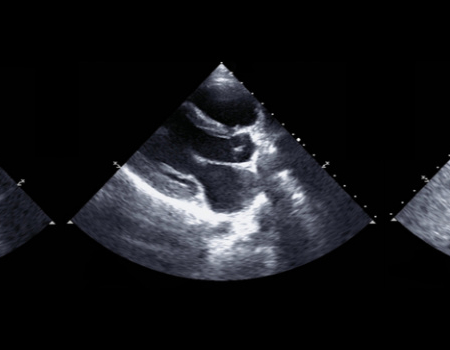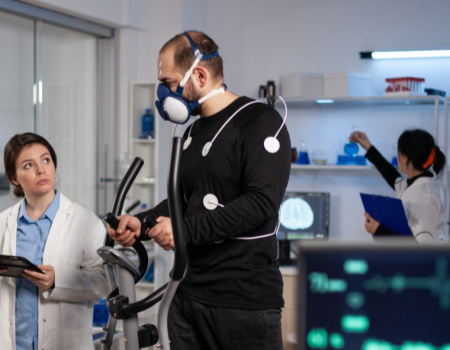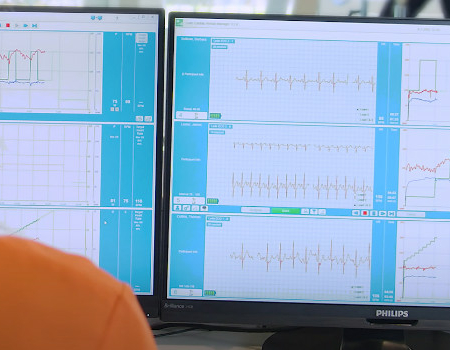Knowledge Hub
Cardiopulmonary Exercise Testing: What Is It, Benefits & Applications
Cardiopulmonary exercise testing, or CPET, is a test of the working capacity of the cardiovascular and pulmonary systems during exercise. This test is often performed on a treadmill or a bicycle ergometer and enables insights into your overall health and fitness level.
This can be used for the benefit of the medical, fitness and educational fields. So, what is cardiopulmonary exercise testing and why is it so important?
Understanding the Cardiopulmonary System
Our cardiopulmonary system consists of the cardiovascular and pulmonary system. Both the cardiovascular and pulmonary systems are measured during a cardiopulmonary exercise test (CPET). Understanding these components is crucial to understanding the overall role of the CPET.
The cardiovascular system, also known as the circulatory system, is responsible for transporting oxygen, nutrients, and waste products throughout the body. It consists of the heart, blood vessels, and blood. The heart acts as a pump, continuously pumping oxygen-rich blood to the body's tissues and organs, while simultaneously removing waste products.
The blood vessels, including arteries, veins, and capillaries deliver blood throughout the body. This intricate system allows for the exchange of gases, nutrients, and waste products, ensuring the proper functioning of our body's cells.
The second part of your body placed under examination in the cardiopulmonary exercise test is the pulmonary system. This is responsible for the exchange of oxygen and carbon dioxide in your body.
The pulmonary system consists of:
- Lungs: Responsible for taking in oxygen from the air and releasing carbon dioxide.
- Bronchi: These branching tubes connect your trachea to your lungs, providing a pathway for air to travel.
- Alveoli: Tiny air sacs, located at the end of your bronchioles, where the actual exchange of gases takes place.
- Diaphragm: This dome-shaped muscle plays a crucial role in your breathing process by contracting and relaxing to help you inhale and exhale.
- Capillaries: These tiny blood vessels surround your alveoli and allow for the exchange of oxygen and carbon dioxide with your bloodstream.
Benefits of Cardiopulmonary Exercise Testing
Cardiopulmonary exercise testing is conducted by a healthcare professional for a variety of reasons, including monitoring the exercise tolerance of healthcare patients as well as individuals, such as athletes.
Improved Cardiovascular Health
One of the benefits of performing a CPET is to improve cardiovascular health. CPET evaluates the performance of the heart and blood vessels during physical activity, allowing individuals to gain valuable insights into their cardiovascular fitness and identify any potential issues or limitations.
This information can be used within medical applications, such as informing diagnosis and prognosis of any cardiovascular diseases or defects as well as preoperative or postoperative understanding. It can also be used to help individuals looking to improve their cardiovascular performance, such as professional athletes.
Increased Lung Capacity and Efficiency
In the same vein, CPET also measures lung capacity and efficiency. This can be used to inform medical patients on the health of their pulmonary and respiratory system, as well as other individuals, such as athletes, who are looking to improve their lung capacity and efficiency whilst exercising.
Enhanced Endurance and Stamina
Engaging in CPET under the supervision of a healthcare provider can enhance the endurance and stamina of individuals such as athletes, firefighters and more.
During CPET, your body is challenged to perform at higher intensities for short durations. Monitoring the results of this test over time tracks the progress of the cardiopulmonary system and its exercise tolerance; this can be used to structure fitness plans and healthcare programmes for building physical endurance and mental stamina.
Weight Management and Calorie Burning
The results of a CPET enables healthcare professionals to prescribe safer weight loss programmes than what could be predicted from a person’s height, weight, age or self-reported level of activity; this is due to a CPET more accurately determining an individual’s exercise tolerance.
They can also be used to monitor the performance of the cardiovascular and pulmonary systems whilst undergoing a weight loss programme to ensure the patient isn’t putting their cardiopulmonary system under too much stress.
What Are the Uses of Cardiopulmonary Exercise Testing?
CPET has several important roles within the medical, fitness and academic sectors.
Medical CPET
To assess medical patients, cardiopulmonary exercise testing can be used by healthcare providers to evaluate their cardiovascular and respiratory function. CPET provides valuable information about the patient's exercise capacity and helps in diagnosing and managing various medical conditions.
For instance, CPET is used within the medical sector to:
- Determine the conditions and severity of heart and lung diseases by measuring their exercise tolerance.
- Assess the effectiveness of treatment interventions by comparing pre- and post-exercise test results.
- Identify exercise-induced abnormalities, such as arrhythmias (abnormal heart rhythm), that may not be detected during rest.
- Evaluate the patient's readiness for surgery or other medical procedures by assessing their cardiopulmonary reserve.
CPET is a non-invasive and safe test that allows healthcare professionals to gather important data to guide patient management. It helps in tailoring individualised treatment plans and monitoring the progress of patients with various medical conditions.
Fitness CPET
CPET allows athletes to advance their fitness programmes and training, providing valuable insights into your cardiovascular and respiratory function that enables a tailored fitness regime suited to the individual’s needs and goals.
By analysing various parameters such as heart rate, oxygen consumption and ventilation, CPET can determine aerobic capacity and identify any limitations or inefficiencies in cardiovascular and respiratory systems.
This information is crucial in designing an effective fitness program that targets individual strengths and weaknesses. With the guidance of a trained professional and quality CPET equipment, CPET can help athletes optimise their workouts, improve endurance, and achieve fitness goals more efficiently.
Educational CPET
Cardiopulmonary exercise testing can contribute to medical research conducted by universities and other academics for the healthcare field. It can also be used for demonstrative purposes, whereby students can validate their understanding regarding the body’s relationship with exercise.
This research is used to develop our comprehension of medical conditions and medical interventions; the cardiopulmonary system and our health; as well as the invention of new medical products and technology.
This information is crucial for developing evidence-based guidelines which can minimise potential risks and side effects of the above.
By integrating CPET into medical research, we can advance the field of healthcare and improve patient outcomes.
Cardiopulmonary Exercise Testing in Summary
Cardiopulmonary exercise testing (CPET) is a valuable clinical tool for assessing the cardiovascular and pulmonary systems. It provides important information about an individual's fitness level and helps diagnose and monitor various conditions.
CPET offers numerous benefits, such as determining exercise capacity and identifying any limitations or abnormalities. It's widely used in clinical settings and sports medicine to optimise treatment plans and enhance performance.
Overall, CPET plays a crucial role in promoting our health and well-being.
Related Articles
Discover more expert guides
Speak to the experts
Got a question?


